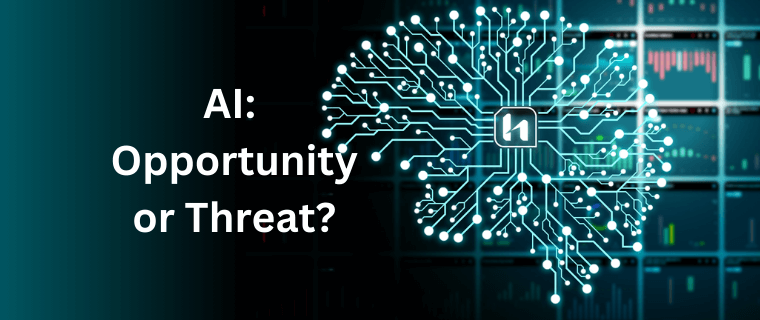AI technologies are increasingly making their path into the CFD Trading industry. For traders and decision makers alike, it is important to understand the relevant AI application areas, and how they can reshuffle market shares. AI can be a threat, but also holds great opportunities. Embracing the technology and staying active will be key.

Retail CFD Trading is a multi-billion Dollar market with high application complexity and high requirements for a sound user experience at the same time. Thereby, it offers outstanding opportunities for AI technologies to challenge the status quo.
Considering the application areas of AI in the retail trading industry, we should carefully assess which AI applications may truly have a significant impact on both brokerage and traders, and which ones may not:
– Autonomous Trading systems based on generative AI will be a battle fought by large institutional firms with deep pockets, rather than retail traders.
– AI-enabled improvements in payments, fraud detection, or customer support may offer some incremental efficiency improvements.
– Building trading bots with ChatGPT may be a fun exercise, but the results often fall short
We should think further and broaden our perspective. With the rise of ChatGPT, we have witnessed that the current AI technology excels in two key aspects: Breaking down complexity using extensive datasets and effectively communicating the important points to the user.
From a trader’s standpoint, this capability could, for example, solve one of their biggest pain points – understand why they experience losses in trading and what they are ‘doing wrong’. With the majority losing in trading, and assuming that this majority doesn’t misinterpret technical or fundamental analysis, we can conclude that there must be another factor causing their continuous losses: their trading behaviors!
Fortunately, the existing AI technology is fully capable of addressing this particular challenge:
– Self-improving algorithms can detect, interpret, and quantify behaviors based on large datasets.
– Large Language Models (LLM), paired with deep learning capabilities, can be custom-trained to effectively communicate those behaviors to traders.
– Real-time integrations can proactively alert traders when identifying destructive behaviors or risk behavior deviations.
Hoc-trade is an example of leveraging these AI technologies for traders, as it automatically identifies individual trading patterns, particularly those leading to losses, and promptly notifies traders whenever they exhibit behaviors indicative of those patterns. Smart algorithms constantly monitor a wide array of trading metrics and are thereby capable of identifying revenge trading, too early closing of profit trades, over trading, and much more. The more trading data is fed into the system, the more precisely the AI can assess, connect, and predict behaviors and create personalized reports highly relevant to the individual trader.
It’s All About the User Experience
Just like any other innovation, the true value of it can only emerge if there is a significant uplift in the user experience. If users find it difficult to understand, struggle to navigate, or need to put in a lot of time and effort to get the full benefits, only innovators and early adopters are likely to utilize it. This is one of the reasons why AI can be very powerful. Aspects that were previously too complex to make it accessible to the general users can now be easily digestible, creating a ’WOW’ experience.
This holds true for a complex topic such as trading behaviors and performance effects as well. When a broker aims to create this outstanding user experience using AI, the output needs to be as easy as a walk in the park. For example, “These are your 3 major trading issues, improving them could uplift your performance by X%. The three most severe issues are manually cutting your profit trades, revenge trading, and too wide Stop Losses”. Each issue can be drilled down into for details, background information, and countermeasure assistance. Brokerages could go even further offering custom-trained LLM chat functionalities or personalized 1-on-1 calls with their top traders.
Trading behaviors are a powerful example of AI applications in trading. However, the same applies to any other area in trading as well, which up until now, was too complex to bring to the general user.
Effect of AI On the CFD Trading Industry
The CFD Trading industry is arguably not as directly disrupted by AI compared to other industries such as IT or Healthcare. However, a range of KPIs will be heavily affected by AI applications in the trading industry, thereby shaping the dynamics and eventually shifting the current market shares.
– Differentiation –
The differentiation by offering AI-powered services to traders will likely have the most obvious and direct impact on the CFD Trading industry. This unique service with high impact will set market players apart from others, influencing major KPIs such as customer acquisition costs or churn.
– Time spent on the platform –
A powerful lever will be the increase in time users spend on the broker platform. AI-related services hold the potential to achieve new levels of customer engagement, enabling market players to grow brand loyalty, deepen customer insights, and allow for cross-selling of ecosystem services.
– More advanced traders –
Fully automated AI trading assistants and learning resources will undoubtedly raise the average trading skills and performance of traders. As a result, retail trading volumes are likely to increase with direct impacts on the revenue generation priorities of brokers.
– Risk management –
AI may not only affect risk management through automation-based cost savings, but it also has the potential to improve the quality of risk management. Gaining real-time insights into behaviors and triggers can become critical insights into simulations and hedging.
Opportunities for Retail Brokerages
As with any other industry, AI presents both threats and opportunities for brokerage firms. Companies must decide whether they want to lead or follow, each option having its own risk-reward profiles. Brokerages have the chance to gain substantial benefits by being early adopters of AI, positioning themselves as pioneers backed by a strong narrative and with the potential to boost various KPIs. The leaders will be the ones that take the biggest leap forward.
One of the biggest risks for brokers would be disregarding AI-related developments and strictly sticking to the usual business practices. While not every new development may directly impact the business, the risk of being left behind is ever-present and the consequences are too high to be ignored.
Whether being the front runner to reap the biggest rewards or tightly managing risks as a follower, the key factor will be whether or not leaders openly embrace new AI-enabled developments and actively seek the opportunities within.

Jonas Schleypen is Co-founder & CEO of Hoc-trade technology Co. Ltd., an AI-powered behavioral trading support application. Hoc-trade serves FX traders through its direct B2C channel as well as offering white label solutions for brokerages and trading firms. In his role, Jonas is actively driving the penetration of AI technologies in the trading industry, creating innovative solutions for traders, and supporting brokers to position themselves for the next generation of technology.
Before founding Hoc-trade, Jonas was a strategy consultant for 6 years and a long-time passionate trader himself. As a consultant, he specialized in and managed data-driven pre-& post-deal value creation programs in Mergers & Acquisitions for Private Equity firms and corporates.
For inquiries, please visit https://hoc-trade.com or reach out to [email protected].












